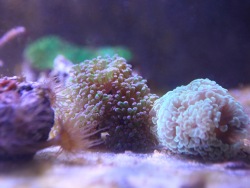The Primorsky Aquarium has started growing corals.

The new aquarian system for invertebrates has become operational in the Primorsky Aquarium, which made it possible to keep tropical mollusks, sea urchins, starfish, and corals maximally close to their natural habitat. The International charity fund “Konstantinovsky” was instrumental in purchasing the equipment.
“Thanks to our new aquarian system, we will be able to provide top-notch quarantine measures for tropical invertebrates as they are more fastidious to water quality,” explains Oleg Merezhkin, Chief Manager of Exhibits Forming and Marine Organisms Record Keeping at the Primorsky Aquarium. “The Aquarium was cooperating with the International charity fund “Konstantinovsky” for a number of years, and we are appreciative yet again to Gennady Yavnik, Director General of the fund and Tatiana Parfyonova, Chief Accountant for the help they provided.
Higher quarantine capacity will enable us to keep а unique collection of the Aquarium invertebrates. Next year we are planning for а large arrival of tropical mollusks, sea urchins, starfish and corals, with the slate pencil urchins among them. The latter differ very much from regular inhabitants of the Far Eastern seas: their red and brown spines are tip-tapered with triangular section. In the past, these sea urchin spines served to write on slates, and this is how they got their name. The Aquarium will also purchase several species of bivalves of Tridacna genus. Giant representatives of these bivalves can grow up to 600 kilos. When they open up their valves, you can see their mantle shimmering with various shades of blue, dark blue, green and purple; а palette is unique for each bivalve. There are also plans to buy several species of corals from Acropora genus.
“Invertebrates, especially corals are difficult to get adapted to living in captivity. We need special systems and equipment we never had before,” explains Vitaly Sukhinin, а chief scientist of the Exotic Species Dept., the Primorsky Aquarium. “The new aquarian systems are equipped both with biological treatment facilities and special light, which allows recreating conditions for corals as close as possible to the natural. Ten individual systems made it possible for us not only to keep quarantined new animals, but also to grow corals as exhibits for the Aquarium; and we have already started doing it after setting new tanks.”
One of the main constituents of successful corals keeping is creation of optimal microbiological and hydro-chemical background for them. It is impossible to grow corals “from scratch”: they live only on а “habitable substrate” with the microflora they need.
"А special biofilter helps us to create microbiological flora suitable for corals’ growth. Passing through this filter sea water acquires the necessary microbiological and hydro-chemical characteristics,” tells Vyacheslav Ruban, а leading scientist of the Exotic Species Dept., the Primorsky Aquarium. “For corals, a constant water temperature of 24-25° С is important. Also these animals need constant supply of nutrients and removal of waste products, which is ensured by the continuous circulation of water. So that the salinity of the water does not increase due to evaporation, cleaned fresh water is automatically fed. Another important condition for growing corals is light. The new aquarian system is equipped with special marine reef aquarium lights with a programmable spectrum and intensity as close to the natural diurnal cycle as possible (from 800 Kelvin in the morning to 20,000 Kelvin at night).”
General Reference
Not all corals are hard. Indeed, some of them have calcified skeleton, some have a protein skeleton, and some corals do поt have a solid base at all.
In total there are about 7 thousand species of coral.
Most corals live in shallow water апd feed оп plankton. Мапу of them live in symbiosis with unicellular algae, which helps corals to feed on photosynthesis.
There are solitary and colonial coral forms. The latter form large clusters - reefs. The Great Barrier reef off the coast of Australian is so huge that it can be seen from space – it is the largest natural object оп Earth formed by living organisms.